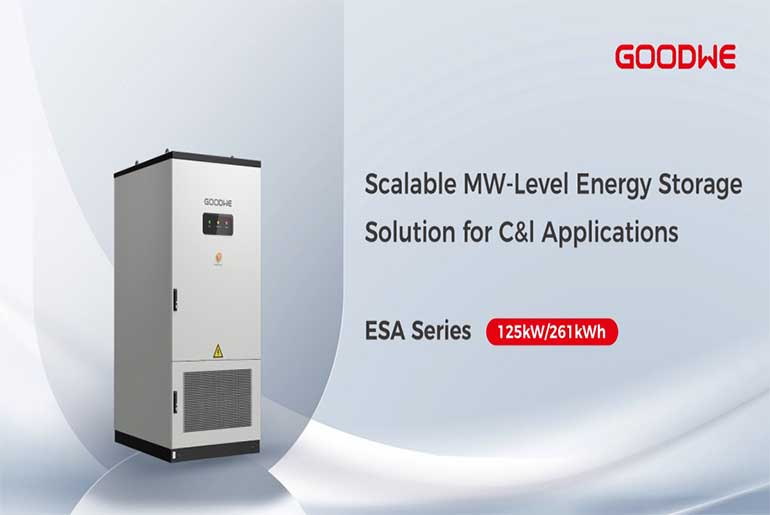GoodWe have launched a fully integrated All-in-One liquid cooled energy storage solution designed for commercial and industrial (C&I) applications with 125 kW nominal output power and 261 kWh storage capacity. The new ESA Series 125kW/261kWh can cover a wide spectrum of use cases in factories, farms, EV charging stations, commercial complexes, and other grid-connected or off-grid applications. By integrating the Power Conversion System (PCS), battery cells, Energy Management System (EMS), and Battery Management System (BMS) within a single cabinet, the ESA Series streamlines installation, operation, and maintenance while supporting flexible capacity expansion. This architecture enables scalability from hundreds of kilowatt-hours to multi-megawatt-hours, supporting up to 15 units in parallel with a total capacity reaching up to 3.91 MWh in on-grid scenarios.
“The ESA series is engineered to deliver the high performance, reliability, safety, and environmental adaptability that today’s commercial and industrial customers expect,” said Jie Zhang, Managing Director of GoodWe Europe GmbH. “GoodWe has a history of constantly innovating storage solutions, tailoring towards the needs of the market for operational efficiency and ensuring long-term investment security.”
Performance and Safety
With a compact footprint of only 1.47 square meters and an energy density of 177.6 kWh per square meter, the ESA cabinet is ideal for sites where space is at a premium. It incorporates top-brand 314 Ah lithium iron phosphate (LFP) cells and advanced liquid cooling technology to maintain temperature consistency across cells and battery packs, even under extreme environmental conditions. Supporting 6,000 life cycles and operating reliably in temperatures from -25°C to 55°C, it is built for continuous operation in energy-intensive applications.
The ESA 125kW/261kWh was tested using UL 9540A methodology, meeting the strictest test standards regarding safety requirements for installation, fire prevention and emergency response. Drawing on GoodWe’s established safety solutions for C&I storage, the ESA features a six-layer protection strategy from the cell to system level, combining active and passive measures for robust fire prevention and suppression. Aerosol-based firefighting modules are integrated in the battery packs as well as the cabinet, which is also equipped with smoke detectors, thermal sensors, and combustible gas detection. Pack-level humidity monitoring with automatic dehumidification ensures optimal internal conditions, further enhancing long-term reliability and operational security. The ESA 125kW/261kWh has been certified by TÜV Rheinland for its comprehensive environmental adaptability, confirming the product’s reliability across multiple environmental domains in climatic, mechanical, chemical, electromagnetic, and specialized scenarios.
Operating projects demonstrate scalability and versatility
The system supports diverse operating modes, including peak shaving, demand control, participation in energy trading, and off-grid backup power, ensuring fast response and precision control. The scalability of up to 15 units connected in parallel makes the All-in-One solution well suited for a wide range of applications. For on-grid scenarios, for example in the combination of ESA storage with GoodWe GT Series inverters, a single or multiple parallel units function together with a GoodWe SEC3000C Smart Energy Controller to support up to 40 string inverters.
Early commercial deployments in China have already reported substantial reductions in power costs and accelerated returns on investment. At GoodWe’s Guangde manufacturing site, nine ESA 125kW/261kWh cabinets were installed in parallel, setting a new benchmark for large-scale C&I storage deployment in Chinese factories. Another project in De’an, China, features seven ESA cabinets with a combined storage capacity of 875 kW/1,827 kWh, which is claimed to be the country’s first charging station project integrating wind, solar, and energy storage. Designed specifically for the heavy-duty truck industry, the project sets a new benchmark for future smart, zero-carbon industrial parks.



